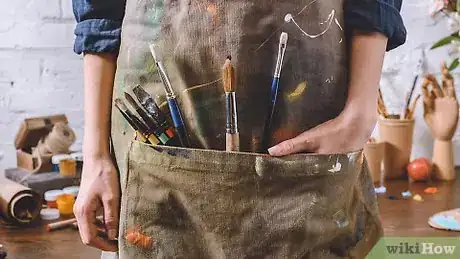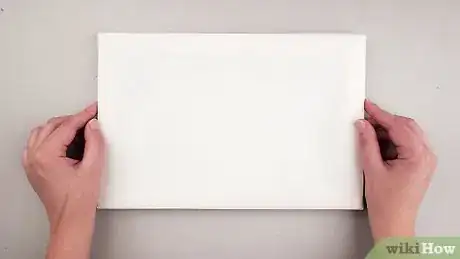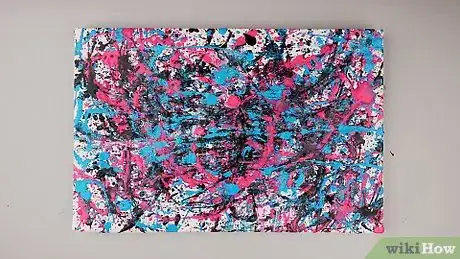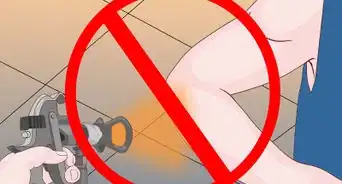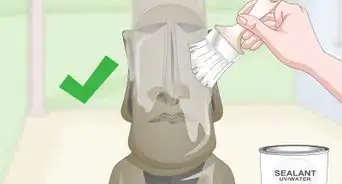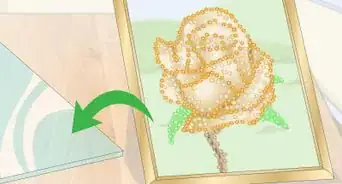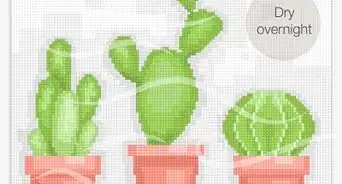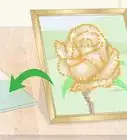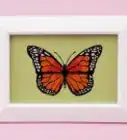wikiHow is a “wiki,” similar to Wikipedia, which means that many of our articles are co-written by multiple authors. To create this article, 26 people, some anonymous, worked to edit and improve it over time.
The wikiHow Video Team also followed the article's instructions and verified that they work.
This article has been viewed 325,469 times.
Learn more...
Painting can be a lot of fun, especially when you can let loose and color outside the lines. Splatter painting can be even more fun because there are no lines restricting your creativity! Splatter painting is an easy and expressive way to create abstract art that simply requires a canvas, paint, and an open mind for disorder!
Steps
Protect Your Clothing and Workspace
-
1Protect your clothing and workspace. When preparing to splatter paint, wear clothes that you wouldn’t mind getting paint on; an old t-shirt, work pants, raggedy shoes, etc.Paint splattering can get messy, so it’s important to find a work area that is open, and contains very few objects that could get ruined by splattered paint. Now that you have the focal point of where the paint is going to be splattered, protect the area around your canvas from getting splattered with paint.
- Consider wearing an apron if you want to protect your clothing even more.
- Some people wear protective gloves when splatting paint, since the paint gets everywhere, but wearing gloves is optional.
- Plastic tarp and drop clothes work well for covering large areas behind your canvas such as walls and the floor.[1]
- If you are working on a smaller canvas, consider laying out newspaper behind your canvas.
- If your canvas is positioned upright, rather than lying on the floor, protect the area behind the canvas, as well as below it. Paint will surely get on the floor when you’re splattering, and with gravity, paint may even drip down off the canvas onto the floor.
-
2Set up your canvas. There are many options for situating your canvas. You can lay your canvas on a table, on the floor, mount the canvas to a wall, position the canvas on an easel, or even prop the canvas on a chair. However you position your canvas, but sure that it is secure, and won’t move.
- If you are painting an object rather than a canvas, still make sure that the object is secure where you position it, and won’t move out of place.
Advertisement -
3Set up your paints and palette. Thicker paints work best for splattering paint. However, most of the time, splatter patterns turn out better when the paints are watered down a little bit.[2] When splattered onto the canvas, looser paint will have more of a splatter effect, as opposed to gloopy blob patterns made with thicker paint.
- To loosen your paints, simply pour out your paints and keep them separated using a paint plate or plastic cups. Be generous with the amount of paint you use, splattering tends to use up more paint quickly. Then add a small amount of water to the paint (approximately 1 teaspoon) and mix the paint and water together.[3] Test the consistency of the paint. You can always add more paint to make the paint thicker, or add more water to make the paint looser.
- Make sure that every color you plan to use has it’s own paintbrush. This will ensure that the paints stay separate, vibrant, and true to color.
Splattering The Paint
-
1Limit the area of the splatter. If you want your splatters to only be on a certain portion of the canvas, use painters tape to surround that section, and cover up the surrounding canvas.[4] For example, if you want to make a painting where one side is splattered with reds and oranges, and one side is splattered with blues and purples, use tape to split the canvas in half, and then cover the portion you don’t want to work on just yet. That will leave the section of the canvas you do want to focus on as the available canvas space to splatter.
- This step is optional since you might not want to section off any parts, and just want to splatter all over the canvas.
- However, if you do want to focus on splatter a specific portion of the canvas, you first must restrict that space before you start painting.
-
2Add paint to a brush and position yourself. Dip your paintbrush into the paint. All the bristles of the brush should be saturated with paint. If the paint drips off the brush before you move toward the canvas, you may want to thicken the paint.
- Stand back from your canvas, once you get started painting, you can experiment with the distance you stand from the canvas.
- If you want thicker splatters, try standing closer to the canvas.
- If you want smaller splatters, stand further back.
- When you’re ready to splatter paint onto the canvas, pull your arm back near your head.
-
3Splatter paint onto the canvas. With a quick whipping motion, bring your arm down toward the canvas, and flick your wrist.[5] The quick movement will throw the paint from the brush onto the canvas, creating the splattered effect. Since splattering paint is free form, experiment with various ways of splattering. Stand at different distances from your canvas, use bigger and smaller brushes, move your arm at various speeds and directions, etc.[6] Using your arm and wrist is a general way to create paint splatters, but splatters can be made in a various other ways:
- Scooping – Scoop up a small amount of paint with a plastic spoon (don't use a spoon you'll eat with afterwards, as even traces of the paint could be bad to ingest). Turn the spoon away from you, so the paint is facing the canvas. Hold the handle of the spoon with one hand, and pull back the top of the spoon with your other hand. Then let go of the top of the spoon to sling shot paint onto the canvas.
- Wrist flicking – Load an ample amount of paint onto the brush and simply use your wrist to flick the brush toward the canvas. This will create harsh, concentrated splatters rather than the spread out, looser splatters made my using your entire arm to splatter the paint.
- Straw blowing – Dip one end of a straw into the paint. Bring the straw over to your canvas, and place your mouth on the other (clean) side of the straw. Hover the straw about an inch above the canvas, and forcefully blow through the straw to transfer the paint from the straw onto the canvas. This method to splattering paint makes small, concentrated splatter marks, spreading on from a focal point.
-
4Continue painting. Continue to use different brushes and paints to create your splatter painting. You may want to consider allowing each layer of splattered paint to dry before adding on more paint, and possibly blending the colors.
-
5Finished.
Community Q&A
-
QuestionWhat kind of paint do I need?
 Community AnswerAnything that paints will work fine. Acrylic, for example, would be vibrant and colorful while watercolor would be lighter.
Community AnswerAnything that paints will work fine. Acrylic, for example, would be vibrant and colorful while watercolor would be lighter. -
QuestionWill a thin paintbrush or thick paintbrush work well for this?
 Community AnswerBoth thin and thick paintbrushes will work well for this, depending on the size that you want. If you want bigger/thicker stains, use a thicker paintbrush and vice-versa.
Community AnswerBoth thin and thick paintbrushes will work well for this, depending on the size that you want. If you want bigger/thicker stains, use a thicker paintbrush and vice-versa. -
QuestionDoes watercolor work?
 Community AnswerYes, you can create the splatter effect with watercolors. You may need to make it a bit more watery with panned watercolors, but it looks nice at the end.
Community AnswerYes, you can create the splatter effect with watercolors. You may need to make it a bit more watery with panned watercolors, but it looks nice at the end.
wikiHow Video: How to Splatter Paint
Warnings
- Remember to lay newspaper down! If you don't you will probably have more of a mess to clean-up⧼thumbs_response⧽
- Be careful if you don't wear a smock! Some paints can stain. Be sure to wear clothes you wouldn’t mind getting paint on.⧼thumbs_response⧽
Things You'll Need
- Paintbrushes/Straws
- Smock
- Paper/Canvas
- Old Newspapers
- Paints
- Brushes
References
- ↑ https://www.youtube.com/watch?v=dapBBbNPQhY
- ↑ http://crate.typepad.com/cratepaper/2010/05/splatter-paint-tutorial-ronda-palazzari.html
- ↑ https://www.youtube.com/watch?v=FwE8dCDoEiM
- ↑ https://www.youtube.com/watch?v=dapBBbNPQhY
- ↑ https://www.youtube.com/watch?v=FwE8dCDoEiM
- ↑ http://homeguides.sfgate.com/splatter-paintings-76559.html
About This Article
Before you splatter paint, lay down some newspaper under your canvas so you don't make a mess on your work surface. Then, thin some paint with a small amount of water in a plastic cup so that it drips off your brush more easily. Next, dip a paintbrush into the paint, making sure all the bristles are saturated. Stand back from the canvas and use a quick whipping motion of your wrist to flick paint onto your canvas. Alternatively, try dipping the end of a straw into the paint, then blowing through the other end to spray paint onto the canvas. For tips on how to keep colors from running together on your canvas, read on.
